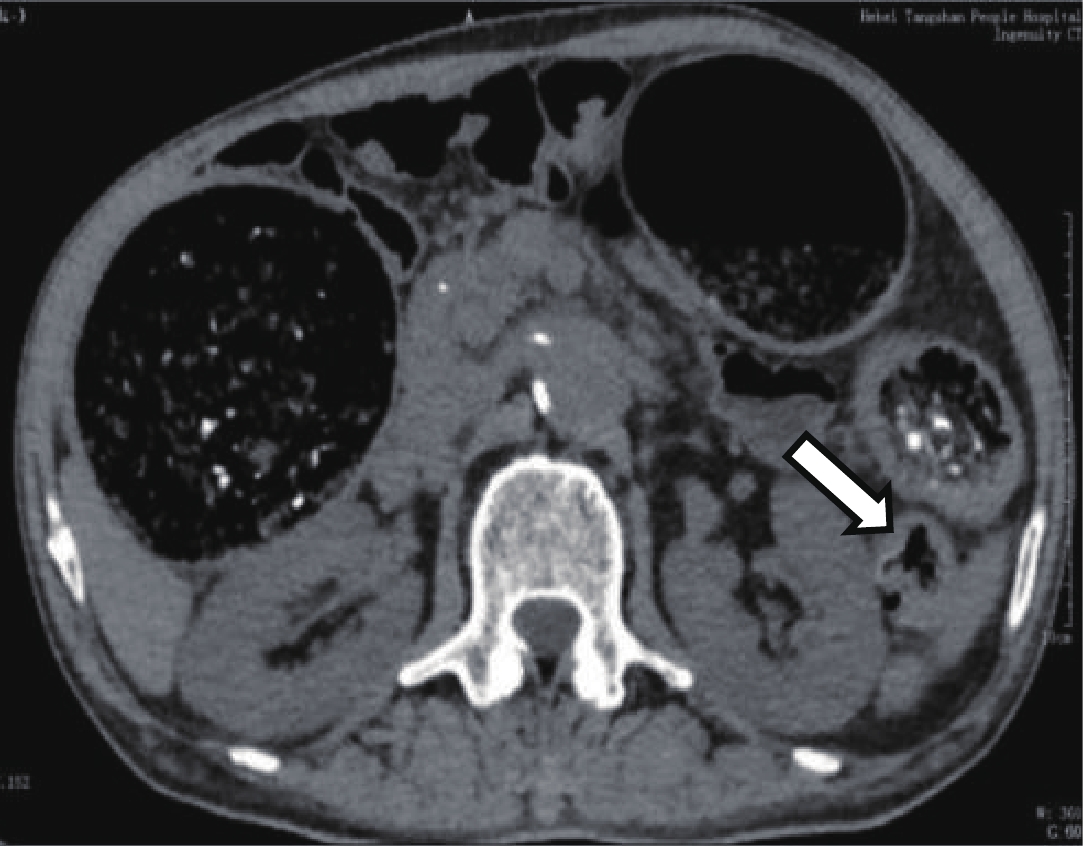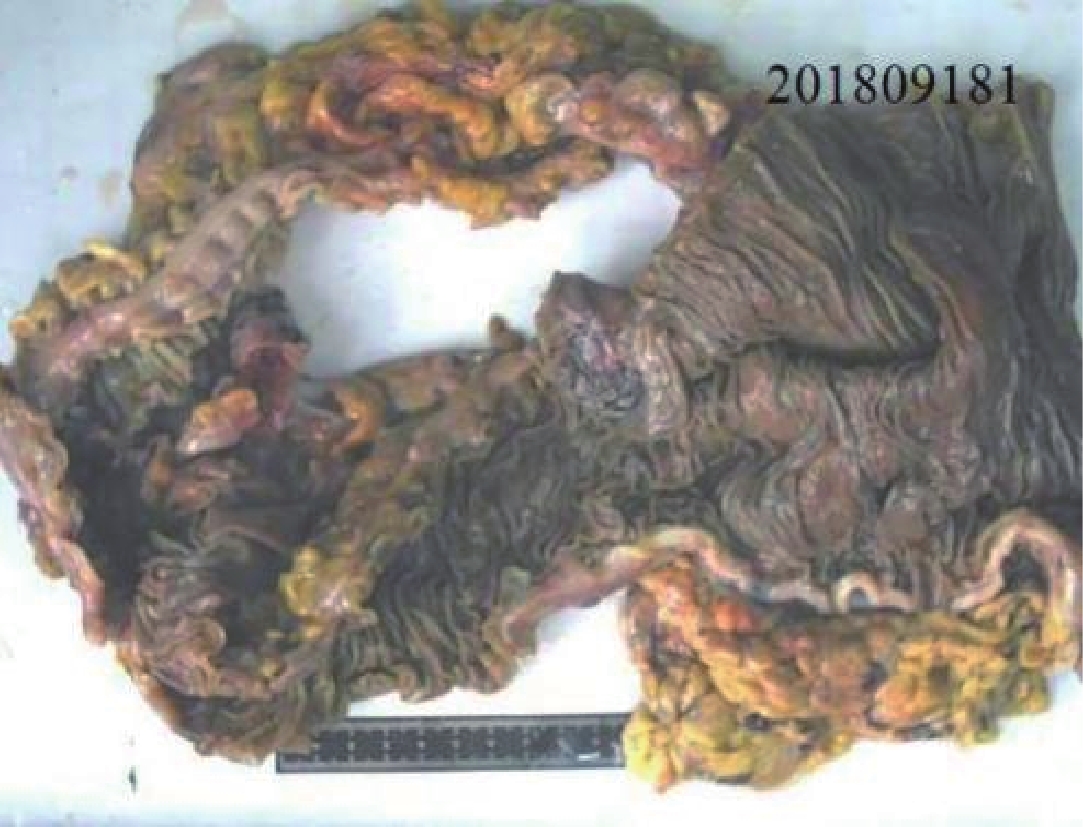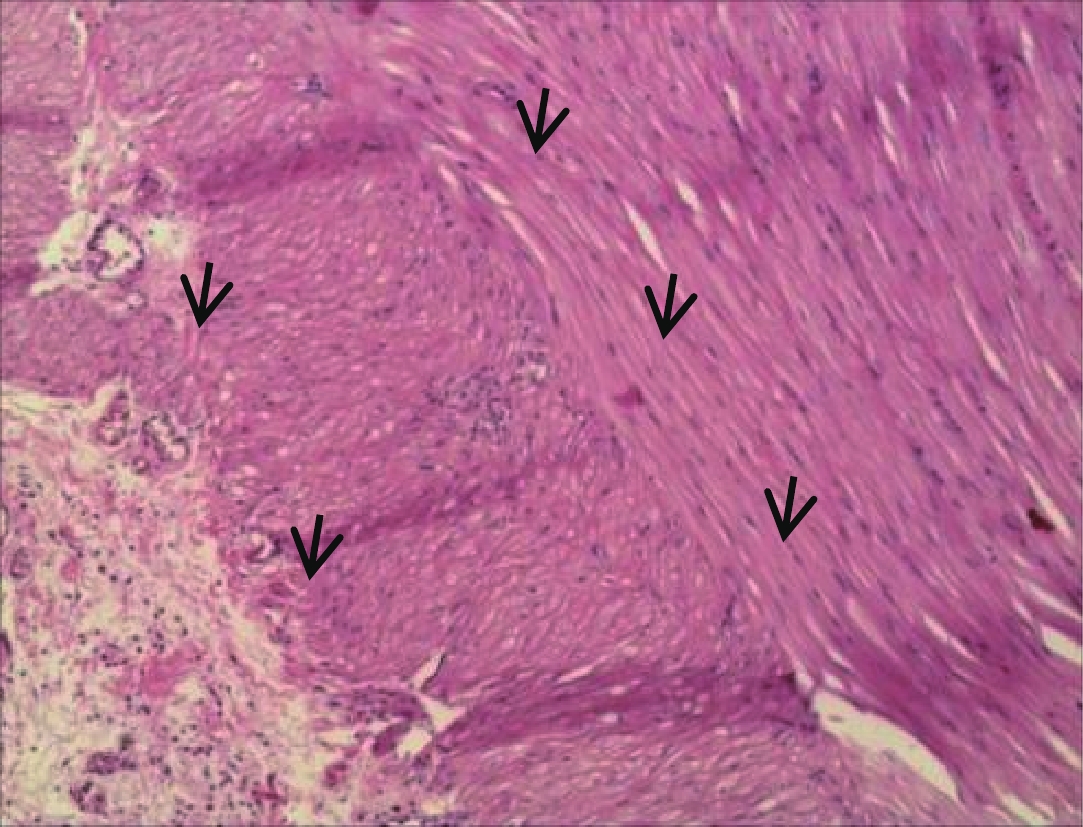Clinical and Multilayer Spiral CT Diagnosis of Colon Innervation Defect
-
摘要: 目的:分析结肠神经节缺乏症的多层螺旋CT(MSCT)的影像和临床表现,提高对结肠神经节缺乏症认识。方法:回顾性分析经手术病理证实的结肠神经节缺乏症患者临床以及MSCT影像资料。检查设备采用GE Discovery 750 HD宝石能谱CT和Philips Brilliance Ingenuity 128层多层螺旋,层厚1 mm,层间距1 mm,管电压120 kV,自动管电流,扫描范围自膈顶扫描至双侧耻骨联合下缘。在肠道自然状态下CT扫描(不做肠道准备,即不清洁灌肠和洗肠),扫描后在CT工作站进行MPR三维重建,在PACS系统存档分析。观察MSCT病变段肠管位置,分别测量扩张段和狭窄段肠壁厚度;对病理标本测量狭窄段(病变段)肠管长度;通过多期MSCT观察肠道蠕动情况;通过增强观察肠道血运情况;总结结肠神经节缺乏症患者的临床特征性表现。结果:结肠神经节缺乏症的临床特点表现为成年人长期的便秘和不完全性肠梗阻。本组5例成人结肠神经节缺乏症患者,病变部位分别位于结肠脾曲和降结肠,其中病变段为狭窄段肠管,扩张段结肠为次生继发性改变,病变段肠管位于降结肠3例,位于结肠脾曲2例;MSCT表现为病变段结肠相对狭窄和病变近端结肠扩张,影像特征表现为结肠扩张后狭窄;测量扩张段和狭窄段肠壁厚度:狭窄段病变区肠壁厚度正常,扩张段肠壁厚度正常或有所增厚,本组增厚的肠壁厚度小于0.9 cm;测量病变段肠管长度:本组病变段肠管长度介于4.3~8.6 cm之间;观察结肠血供和肠道功能情况:MSCT增强扫描肠系膜血管以及系膜密度均未见异常改变、病变段结肠肠壁无异常强化,提示扩张与狭窄段结肠血供正常;MSCT三期增强扫描显示病变段肠管僵直、无蠕动,提示病变段肠管蠕动功能丧失。结论:结肠神经节缺乏症具有结肠扩张后狭窄特征性的影像学表现和临床特点,MSCT结合临床资料能够在术前提示结肠神经节缺乏症的诊断。Abstract: Objective: To analyze the image performance of colon innervation defect with multilayer spiral CT (MSCT) and clinical manifestations, summarize its image characteristics and make correct diagnosis. Methods: The clinical features of colonic innervations deficiency present with prolonged constipation and incomplete ileus. MSCT imaging data using GE gem energy spectrum, CT 750 HD, and Philips MSCT. 1 mm layer thickness, 1 mm layer spacing, tube voltage, 120 kV, automatic tube current from the diaphragm to the bilateral pubic joint. Scan in the natural state of the intestine (No bowel preparation, no cleansing enema and bowel cleansing), after scanning, conduct MPR 3D reconstruction at the CT workstation, and the reconstructed data were archived and analyzed in the PACS system. Clarify the intestinal location of the diseased segment, measure intestinal wall thickness of dilated segment and narrow segment respectively; measure intestinal tube length of diseased segment (narrow segment); observe intestinal peristalsis with multiple-stage MSCT; and observe intestinal blood transport through enhancement. Results: The clinical features of colon innervations defect was constipation and incomplete ileus. In this study group, there were 5 adult patients with colon innervations defect, and the lesion site was located in the spleen and descending colon respectively, among which the diseased segment was located in 3 cases and the spleen was located in 2 cases of colon; MSCT shows relative narrowing of the colon and expansion of the proximal colon; The intestinal wall thickness was normal in the diseased area, and the intestinal wall thickness of the dilated colon section was normal or somewhat thickened, and the thickened intestinal wall in this group is less than 0.9 cm; The intestinal length of the diseased segment in this group was somewhere between 4.3~8.6 cm. The MSCT enhancement scan of mesangic vessels and mesangial density showed no abnormal changes, and no abnormal enhancement of the colon wall in the diseased section, suggesting normal blood supply; MSCT enhanced scan showed rigidity and no peristalsis in the diseased segment, suggesting loss of peristaltic function in the diseased segment. Conclusion: Colonic innervations defect has imaging findings of characteristic post dilating stenosis and clinical features of prolonged constipation and incomplete obstruction in adults, The MSCT combined with clinical data was able to indicate the diagnosis of colonic innervations defect before surgery.
-
源于滤泡细胞的甲状腺癌占甲状腺恶性肿瘤的95%,其中的80%~85%是甲状腺乳头状癌(papillary thyroid carcinoma,PTC)[1]。手术是治疗PTC的首选方法,然而部分PTC患者术后易复发和远处转移,导致预后不良,甚至死亡[2]。相当研究表明,颈部中央区淋巴结转移(central lymph node metastasis,CLNM)是PTC患者预后差的独立危险因素[3]。由于目前临床缺少术前预测CLNM的有效技术,术中冰冻切片证实为PTC的病例,常规执行预防性的中央区淋巴结清扫(prophylactic lymph node dissection,PLND)[4]。然而,过度的PLND不仅增加患者不必要的损伤,甚至引起严重的并发症[5]。因此,探索建立术前精准评价PTC患者颈部淋巴结状态的有效新方法,成为亟待解决的重要科学问题。
目前,PTC患者颈部中央区淋巴结状态术前检查的方法主要包括体格检查、超声、CT、MRI和PET等,其中触诊的敏感性低于7%,超声和CT的敏感性为50%~60%[6-7],MRI和PET常因为呼吸道伪影的干扰,小的淋巴结不易显示[8]。甲状腺功能检查指标的水平与CLNM的发生的相关性也被广泛研究,但研究成果差异很大[9-11]。近年来,利用PTC原发灶的多参数特征构建模型术前预测CLNM逐渐成为研究热点,然而,大多数模型的建立涉及到术前不能明确或须经手术病理证实的特征,如甲状腺外侵犯、血管外侵犯、BRAFV600 E变异、桥本氏甲状腺炎(Hashimoto’s thyroiditis,HT)、TNM分期等[12],致使临床上应用受限。
本研究针对上述问题,以PTC患者术前临床信息、超声及CT影像学数据联合甲状腺功能检查的多参数特征为基础,构建预测模型,精准预测PTC患者的颈部CLNM。其特点是所有的预测因素术前可得,同时考虑到原发病灶与CLNM确定的对映关系,我们选择单灶性PTC,以增加研究结果的可解释性。
1. 对象和方法
1.1 病例筛选
连续收集2019年1月至2023年12月在我院外科行甲状腺癌根治术患者的临床、CT、超声及实验室检查的资料。上海市金山区亭林医院伦理委员会批准此项研究,所有的患者免除签订知情同意书。
纳入标准:患者甲状腺腺叶或全甲状腺切除术+颈部中央区淋巴结清扫,术后病理是单灶性PTC;术前两周在我院行甲状腺CT增强检查;术前两周在我院行甲状腺超声检查;术前一周在我院行甲状腺功能检查。
排除标准:PTC最大径小于3 mm;既往有甲状腺或头颈部其他肿瘤手术史;Graves病;图像质量欠佳;临床信息不完整。
按照纳入标准和排除标准,340例患者入组本研究。
1.2 方法
本研究方法包括变量的定义和分类;根据变量的性质选择不同的统计方法;以及选择用于模型构建的编程语言等。
2. 图像分析
2.1 临床特征和甲状腺功能检查指标
性别(男和女);年龄分组(≤55岁和>55岁);TSH(参考值,以下同:0.55~4.78 mIU/L);fT3(3~6.3 pmol/L);fT4(10.3~24.5 pmol/L);TT3(1.3~3.1 nmol/L);TT4(66~181 nmol/L);TG-Ab(0~60 IU/ml);TPO-Ab(0~60 IU/ml)。
2.2 CT影像特征
在未知CLNM病理结果的情况下,由两位具有10年以上头颈部放射诊断工作经验的医师(医师1和医师2)各自分析340例患者的CT图像特征。包括,CT值:正常甲状腺实质和同侧胸锁乳突肌的平扫CT值和差值,两者感兴趣区保持面积一致;PTC与甲状腺被膜接触程度:依据PTC与甲状腺包膜最大接触长度与肿瘤周长的比值,分为0、<25%、25%~50%和>50%;病灶位置分布:位置1(左叶、峡部、右叶)、位置2(上部、中部、下部);病灶实质构成:依据病灶内是否存在液性无强化区分为实性、囊实性及囊性。两位医师意见不一致时通过讨论或者咨询医师3(具有16年头颈部放射诊断工作能力)决定。
2.3 超声影像特征
在未知CLNM病理结果的情况下,两位具有8年以上甲状腺超声诊断工作经验的医师(医师4和医师5)分析340例患者的甲状腺超声图像特征。包括:病灶回声特点(低回声、等回声、高回声);形态特征(圆形或类圆形,边缘无明显分叶状或刺状定义为规则);肿瘤边界(肿瘤边缘与正常甲状腺实质界限可辨,称为清晰);肿瘤最大径(≤10 mm和>10 mm);肿瘤前后径(A)和左右径(T),并计算A/T比(≤1和>1);钙化特点(无钙化、直径≤3 mm和>3 mm);彩色多普勒血流显像(CDFI) (无血流、周围血流、中央血流、周围+中央血流)。
3. 统计学分析
单因素分析中,符合正态分布的计量资料用(
$\bar x \pm s $ )表示,t检验分析,不符合正态分布的计量资料用Mann-Whitney U检验;计数资料用Pearson$ \chi^ 2 $ 检验(最小期望值≤5用Fisher精确$ \chi ^2 $ 检验);多因素logistic回归向前法筛选IRF;列线图的评价指标包括ROC曲线、calibration和DCA;医师之间的评判一致性用Kappa检验。所有的假设检验采用双尾检验,P<0.05表示差别有统计学意义,使用的软件包括SPSS19(SPSS/IBM,Chicago)和R2.15.3软件。4. 结果
本研究的340例PTC患者中,男性88例(25.9%),女性252例(74.1%),年龄范围19~83岁(50.60±13.243)。131例患者发生了CLNM(38.5%,男性50例,女性81例)。2个临床特征(年龄分组、性别)、4个CT影像特征(位置、内部构成、被膜接触、差值)、7个超声影像特征(回声、边缘、边界、最大径、A/T比、钙化、CDFI)以及甲状腺功能检查的7项指标被纳入研究。医师1、2和4、5之间各个征象评价一致性的Kappa检验系数>0.75。年龄≤55岁、男性性别以及肿瘤最大径>10 mm是CLNM的高危因素,PTC与被膜接触、边缘不规则生长、钙化以及病灶内发生囊变更容易发生CLNM,差异有统计学意义(表1和表2)。
表 1 CLNM分组的临床和实验室特征单因素分析Table 1. Univariate analysis of clinical and laboratory characteristics in the CLNM group特征 CLNM(n=131) Non-CLNM(n=209) T值 P值 年龄 46.27±13.68 53.32±12.23 -4.933 0.000 年龄分组(n%) 11.284 0.001 ≤55 93(71.0) 110(52.6) >55 38(29.0) 99(47.4) 性别(n%) 16.768 0.000 男 50(38.2) 38(18.2) 女 81(61.8) 171(81.8) TSH 1.933±1.117 2.086±1.173 -1.13 0.259 fT3 5.101±0.781 4.975±0.663 1.584 0.114 fT4 17.414±3.682 17.382±2.955 0.086 0.932 T3 1.768±0.322 1.755±0.316 0.345 0.730 T4 111.3±25.346 113.0±24.016 1.233 0.218 TG-Ab 22701 35269 -0.423 0.673 TPO-Ab 22332.5 35673.5 -0.004 0.997 表 2 CLNM分组的影像特征单因素分析Table 2. Univariate analysis of imaging characteristics in the CLNM group特征 CLNM(n=131) Non-CLNM(n=209) T值 P值 边缘(n%) 17.044 0.000 规则 23(17.6) 81(38.8) 不规则 108(82.4) 128(61.2) 边界(n%) 0.123 0.725 清晰 92(70.2) 143(68.4) 模糊 39(29.8) 66(31.6) 位置1(n%) 1.861 0.394 右叶 59(45.0) 103(49.3) 峡部 14(10.7) 14(6.7) 左叶 39(29.8) 92(44.0) 位置2(n%) 0.395 0.821 上 32(24.4) 45(21.5) 中 64(48.9) 107(51.2) 下 35(26.7) 57(27.3) 实质构成(n%) 7.83 0.005 实性 93(71.0) 175(83.7) 囊实性 38(29.0) 34(16.3) 被膜接触(n%) 34.526 0.000 0 8(6.1) 51(24.4) <25% 34(26.0) 62(29.7) 25%~50% 35(26.7) 61(29.2) >50% 54(41.2) 35(16.7) 最大径(n%) 32.544 0.000 ≤10 mm 66(50.4) 167(79.9) >10 mm 65(49.6) 42(20.1) A/T 比(n%) 0.003 0.959 ≤1 83(63.4) 133(63.6) >1 48(36.6) 76(36.4) 钙化(n%) 9.201 0.010 无 44(33.6) 105(50.2) ≤3 mm 72(55.0) 84(40.2) >3 mm 15(11.5) 20(9.6) CDFI(n%) 5.073 0.167 无 60(45.8) 118(56.5) 周围 24(18.3) 38(18.2) 中央 40(30.5) 47(22.5) 周围+中央 7(5.3) 6(2.9) 差值* 33.09±16.459 34.37±16.754 -0.693 0.489 注:*甲状腺实质与同侧胸锁乳突肌CT值之差。 对单因素分析中P值<0.05的特征(年龄分组、性别、肿瘤最大径、被膜接触、实质构成、边缘以及肿瘤内钙化)进行多因素logistics回归向前法分析,结果表明,年龄≤55岁、男性性别、肿瘤最大径>10 mm、被膜接触>0以及边缘不规则是CLNM的IRFs(表3)。
表 3 340例PTC患者CLNM的多因素logistics回归分析Table 3. Multivariate logistic regression analysis for CLNM in 340 patients with PTC变量 估计值 标准误 Z值 P 值 截距 -2.596 0.688 -3.773 0.000 年龄(>55) -0.755 0.332 -2.272 0.023 性别(女) -0.993 0.362 -2.739 0.006 边缘(不规则) 1.153 0.390 2.856 0.003 最大径(>10 mm) 1.051 0.362 2.898 0.003 构成(囊实性) 0.343 0.397 0.863 0.388 被膜接触 <25% 1.791 0.622 2.879 0.004 25%~50% 2.005 0.623 3.217 0.001 >50% 2.520 0.632 3.984 0.000 钙化 ≤3 mm 0.003 0.350 0.008 0.993 >3 mm 0.515 0.591 0.871 0.384 340名PTC患者以7∶3随机分成训练组(n=273)和验证组(n=103),IRFs在随机分组中的差异无统计学意义(表4)。依据IRFs在多因素logistic回归分析中的权重,在训练组构建列线图(nomogram)(图1),并在验证组验证。结果显示,Nomogram的ROC在训练组的曲线下面积(area under the curve,AUC)为0.815(95%CI:0.761~0.870),在验证组中的AUC值0.747(95%CI:0.646~0.848)(图2)。Nomogram预测个体患者CLNM发生概率的实例演示如图3。
表 4 340例PTC患者7:3比例随机分组中IRF的比较Table 4. Comparison of IRFs in the training and validation cohorts where 340 PTC patients were randomly divided into at a 7:3 ratio特征 训练组(n=237) 验证组(n=103) T值 P值 年龄分组(n%) 0.015 0.904 ≤55 141(59.5) 62(60.2) >55 96(40.5) 41(39.8) 性别(n%) 0.200 0.655 男 63(26.6) 25(24.3) 女 174(73.4) 78(75.7) 边缘(n%) 1.325 0.250 规则 68(28.7) 36(35,0) 不规则 169(71.3) 67(65.0) 被膜接触(n%) 1.903 0.593 0 45(19.0) 14(13.6) <25% 68(28.7) 28(27.2) 25%~50% 64(27.0) 32(31.1) >50% 60(25.3) 29(28.2) 最大径(n%) 0.162 0.687 ≤10 mm 164(69.2) 69(67.0) >10 mm 73(30.8) 34(33.0) ![]() 图 3 Nomogram预测CLNM的性能演示(界值为0.303)注:患者1,男性,44岁,PTC病例,CLNM阳性。CT平扫示右叶中下部类圆形病灶,内见钙化,与甲状腺被膜接触约75%(a),增强后不均匀强化(b),超声显示低回声区,境界清晰,边缘光整,约20.6×16,5×18,5 mm(c),对照Nomogram:男性(38分)+年龄<55岁(28分)+被膜接触>50%(100分)+最大径>10 mm(45分)=211分,对应的CLNM预测概率0.73。患者2,女性,37岁,PTC病例,CLNM阴性。右叶内不规则低密度结节,边缘与被膜无接触(d),增强后轻度强化(e),超声显示境界清晰,边缘不光整的低回声区,最大径约8.5 mm(f),对照Nomogram:年龄<55岁(28分)+边缘不规则(48分)=76分,对应的CLNM预测概率0.10。Figure 3. Performance of the nomogram for CLNM (cutoff=0.303)
图 3 Nomogram预测CLNM的性能演示(界值为0.303)注:患者1,男性,44岁,PTC病例,CLNM阳性。CT平扫示右叶中下部类圆形病灶,内见钙化,与甲状腺被膜接触约75%(a),增强后不均匀强化(b),超声显示低回声区,境界清晰,边缘光整,约20.6×16,5×18,5 mm(c),对照Nomogram:男性(38分)+年龄<55岁(28分)+被膜接触>50%(100分)+最大径>10 mm(45分)=211分,对应的CLNM预测概率0.73。患者2,女性,37岁,PTC病例,CLNM阴性。右叶内不规则低密度结节,边缘与被膜无接触(d),增强后轻度强化(e),超声显示境界清晰,边缘不光整的低回声区,最大径约8.5 mm(f),对照Nomogram:年龄<55岁(28分)+边缘不规则(48分)=76分,对应的CLNM预测概率0.10。Figure 3. Performance of the nomogram for CLNM (cutoff=0.303)Nomogram的预测准确性和临床实用性用Calibration和DCA评价(图4和图5),calibration显示预测概率和实际概率在训练训练组和验证组中一致性程度很高。DCA曲线表明,当个体患者预测概率在0.1到0.85范围内,Nomograms预测CLNM的净收益高于无预测组或全部干预组。
5. 讨论
术前精准评价PTC患者颈部淋巴结状态,对于制定临床手术方案、提升患者生存质量具有重要的意义。然而,目前临床对于甲状腺乳头状癌CLNM的术前精准预测方面一直面临巨大挑战。
相当研究表明,年龄≤55岁、男性性别以及肿瘤最大径>10 mm是PTC患者发生CLNM的IRFs[13-14],这与本研究的结果发现相一致。分析认为,不健康的生活习性如抽烟、酗酒以及更高的基础代谢潜在地加速了肿瘤的扩散,可能是低龄男性PTC患者更易于发生CLNM的原因[13,15]。Huang等[16]研究发现常规PTC中,肿瘤直径越大越容易发生多个CLNM。
被膜侵犯是预测甲状腺癌颈部淋巴结转移的重要因素[17],分析认为其机制可能与肿瘤组织突破甲状腺被膜,并侵犯被膜内的淋巴系统有关。本研究中,定义的被膜接触是指CT影像上瘤体与甲状腺被膜之间无甲状腺组织的直接接触,区别于病理上的被膜侵犯。本研究中的被膜接触可以理解为被膜侵犯一种影像征象。被膜接触在术前的CT图像上易于识别和准确定量,正常甲状腺实质高密度的背景下,PTC均表现为低密度,CT平扫期能够清晰地观察到被膜接触的长度。患有HT的患者,甲状腺实质的背景密度减低,可以结合增强动脉期或静脉期的影像比较观察。
HT患者伴发PTC的几率增高,且高于其他类型的甲状腺癌[9]。我们比较了正常甲状腺实质与胸锁乳突肌的CT值差值(考虑到不同机型、不同扫描参数可能引起相同层面CT值的不同,但同一层面不同组织的CT差值可能不变)。研究结果显示差值越小,HT的发生率越高(22.33±15.54 vs 38,22±14.697,P<0.001),但与CLNM的发生无相关性。
研究表明,PTC瘤体发生囊变的机制主要是由癌细胞产生的胶质被液化而形成,因此PTC囊变通常表明肿瘤具有更高的恶性度[18],产生更高的侵袭性和转移能力,因此,也更容易发生CLNM。甲状腺结节内微钙化的检出对甲状腺癌的诊断有高度特异性,特别是PTC[19]。本研究中,单因素分析显示瘤体内囊变和钙化与CLNM的发生都存在相关性,但多因素分析显示缺乏相关性,因此,它们与CLNM的相关性需要进一步研究。
文献中有较多关于甲状腺功能检测指标预测CLNM的报道。Yu等[10]研究认为TPO-Ab和TG-Ab对预测CLNM都有价值,但作用互为相反;岳潇潇等[11]发现甲状腺功能检测指标的水平与PTC是否有淋巴结转移不相关。本研究对340例患者的血清TSH、FT3、FT4、T3、T4、TG-Ab、TPO-Ab表达水平行单因素分析(后两者为偏态分布资料,我们做了Wilcoxon秩和检验),但结果未能显示与CLNM之间的相关性,相关的数据还需要进一步研究证实。
本研究的贡献之处在于,一旦术中冰冻切片确诊为PTC后,外科医生易于根据术前多参数资料计算CLNM的发生概率,辅助决定是否需要预防性的淋巴结清扫,尽可能避免扩大手术范围和不必要的损伤。
本研究的局限性在于,首先,回顾性研究可能会引入一些选择偏倚;其次,单中心、小样本量以及外部验证的缺少,模型可能存在拟合优度过度的问题,产生的Nomogram泛化能力相对较弱;再次,本研究目的是精准分析术前单个PTC的预测能力,排除了多灶瘤及最大径小于3 mm的病例,须经术后病理确诊的特征也未被纳入,模型的预测效能不可避免地降低。尽管存在上述不利因素,我们的模型仍然展示了很好的预测能力和临床实用性,更优质的模型需要多中心、大样本量以及强大的外部验证进一步研究。
-
图 1 上腹CT平扫,横结肠脾曲肠腔扩张内径7 cm,肠壁均一弥漫性增厚,厚约0.5 cm,扩张肠腔内大量粪便集聚;结肠脾曲肠腔相对狭窄(空白箭),肠壁厚0.4~0.6 cm
Figure 1. CT image of the abdomen,The splenic flexure of colon intestinal lumen was dilated, with an internal diameter of 6 cm, and the intestinal wall was diffuse and thickened, about 0.5 cm thick, and a large number of feces were concentrated in the dilated intestinal lumen. Colonic spleen curved intestinal lumen is relatively narrow (blank arrow), and the intestinal wall is 0.4~0.6 cm thick
图 2 上腹CT平扫,横结肠肠腔扩张,大部分肠壁厚度正常、局部肠壁轻微增厚,最厚约0.4 cm,扩张的肠腔内大量粪便;降结肠病变段肠管相对狭窄(空白箭),肠壁厚约0.8 cm
Figure 2. CT image of the abdomen,The transverse colon lumen is dilated, with uneven thickening, the thickest intestinal wall diameter is about 0.4 cm, a large number of fees were concentrated in the dilated intestinallumen. The diseased segment of the descending colon is relatively narrow (blank arrow), the local thickness is about 0.8 cm
图 4 图1患者术后大体标本,肉眼所见:全结肠切除标本:结肠长68 cm,周径5~12 cm,回肠长7 cm,周径3 cm。扩张段肠管长15 cm,周径12 cm,壁厚0.5 cm,粘膜灰红色,质软,皱襞较清晰;狭窄段肠管,长5 cm,周径5 cm,壁厚0.5 cm
Figure 4. The Patient of fig.1, postoperative gross specimen, as seen by the naked eye. Total colon resection specimen: The colon is 68 cm long, the peripheral diameter is 5~12 cm, The ileum was 7 cm long with a circumference diameter of 3 cm. The intestine of the dilated segment was 15 cm long, Peridiameter 12 cm, wall thickness 0.5 cm, Mucosal membrane is grey-red, soft, The wrinkles are clear; The arrow segment intestine, 5 cm long, The circumference diameter is 5 cm and the wall thickness is 0.5 cm
图 5 与图1同一患者,HE染色10×10结合免疫组化S-100,显示狭窄段肠黏膜下层及肌间神经节细胞数量显著减少。病理诊断:结肠神经节缺乏症(结肠假性)
Figure 5. The same patient of fig.1, HE pathological staining, 10×10 combined with immunohistochemistry S-100, a narrow segment of the intestinal mucosa is shown the number of lower and myomuscular ganglion cells was significantly reduced. Pathological diagnosis: Colonic innervation defect (Hirschsprung' Disease)
-
[1] 隋金珂, 张卫. 成人巨结肠病因分析及手术方式选择[J]. 中华胃肠外科杂志, 2021,24(12): 1054−1057. DOI: 10.3760/cma.j.cn441530-20211103-00445. SUI J K, ZHANG W. Etiological analysis and surgical method selection of adult megacolon[J]. Chinese Journal of Gastrointestinal Surgery, 2021, 24(12): 1054−1057. DOI: 10.3760/cma.j.cn441530-20211103-00445. (in Chinese).
[2] STARLING J R, CROOM R D, THOMAS C G. Hirschsprung's disease in young adults[J]. American journal of Surgery, 1986, 151(1): 104−109. DOI: 10.1016/0002-9610(86)90019-x.
[3] 戴春娟, 叶祖萍. 先天性巨结肠遗传学基础研究进展[J]. 河北医药, 2010, 53(4), 89-92. DOI:10.3969/J.issn 1002-7386.2010.04.053. DAI C J, YE Z P. Research progress on genetic basis of Hirschsprung’s disease[J], Hebei Medicine, 2010, 53(4), 89-92. DOI:10.3969/J.issn1002-7386.2010.04.053(in chinese).
[4] 张文, 武海燕, 李惠, 等. 先天性巨结肠病理诊断规范[J]. 中华病理学杂志, 2016,45(3): 149−152. DOI: 10.3760/cma.j.issn.0529-5807.2016.03.002. ZHANG W, WU H Y, LI H, et al. The guideline of pathological diagnosis of Hirschsprung's disease[J]. Chinese Journal of Pathology, 2016, 45(3): 149−152. DOI: 10.3760/cma.j.issn.0529-5807.2016.03.002. (in Chinese).
[5] Isolated hypoganglionosis: Systematic review of a rare intestinal innervation defect[J]. Pediatric Surgery Internation, 2010, 26(11): 1111-1115. DOI: 10.1007/s00383-010-2693-3.
[6] DO M Y, MYUNG S J, PARK H J, et al. Novel classification and pathogenetic analysis of hypoganglionosis and adult-onset Hirschsprung's disease[J]. Digestive Diseases and Sciences, 2011, 56(6): 1818−1827. DOI: 10.1007/s10620-010-1522-9.
[7] HUIZER V, WIJEKOON N, ROORDA D, et al. Generic and disease-specific henlth-ralated quality of life in pentints with Hirschspurung disease: A systematic review and Meta-angnlysis[J]. World Journal of Gastroenterology, 2022, 28(13): 1362−1376. doi: 10.3748/wjg.v28.i13.1362
[8] FRIEDMACHER F, PURI P. Classification and diagnostic criteria of variants of Hirschsprung's disease[J]. Pediatric Surgery Internation, 2013, 29(9): 855−872. doi: 10.1007/s00383-013-3351-3
[9] 王维林. 关于肠神经元发育异常的再思考[J]. 中华小儿外科杂志, 2014,35(7): 481−483. DOI: 10.3760/cma.j.issn.0253-3006.2014.07.001. WANG W L. Rethinking about intestinal neuronal dysplasia[J]. The Chinese Journal of Pediatric Surgery, 2014, 35(7): 481−483. DOI: 10.3760/cma.j.issn.0253-3006.2014.07.001. (in Chinese).
[10] 孙晓毅. 巨结肠同源病诊断治疗难点解析[J]. 中华实用儿科临床杂志, 2014,29(23): 1763−1768. DOI: 10.3760/cma.j.issn.2095-428X.2014.23.002. SUN X Y. A comment on difficulties in diagnosis and treatment of Hirschsprung's disease allied disorders[J]. The Chinese Clinical Journal of Practical Pediatrics, 2014, 29(23): 1763−1768. DOI: 10.3760/cma.j.issn.2095-428X.2014.23.002. (in Chinese).
[11] 朱天琦, 冯杰雄, 张文, 等. 新生儿先天性巨结肠经脐腹腔镜根治术十例报告[J]. 中华外科杂志, 2011,49(11): 1049−1051. DOI: 10.3760/cma.j.issn.0529-5815.2011.11.025. ZHU T Q, FENG J X, ZHANG W, et al. 10 case reports of neonatal Hirschsprung disease by transumbilical laparoscopic colectomy[J]. Chinese Journal of Surgery, 2011, 49(11): 1049−1051. DOI: 10.3760/cma.j.issn.0529-5815.2011.11.025. (in Chinese).






 下载:
下载:












